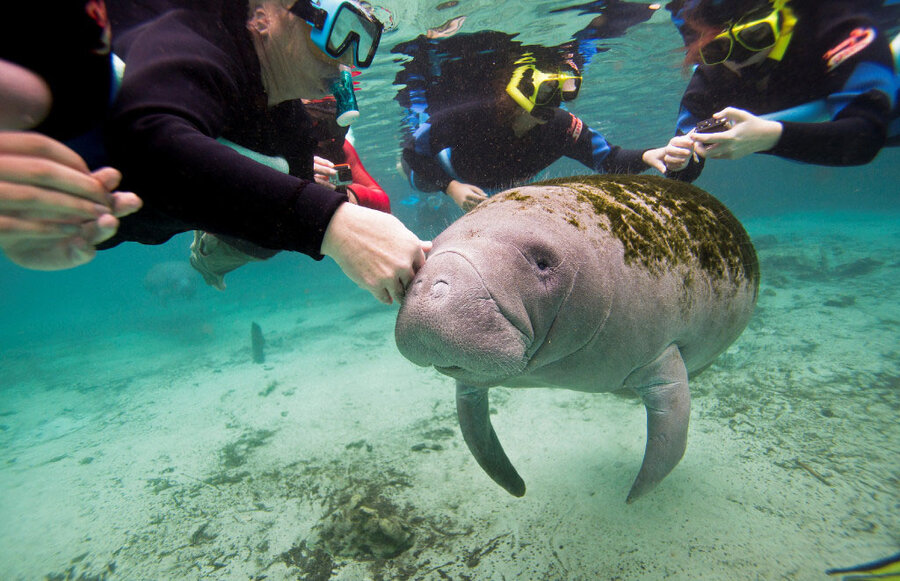Manatees get 'downlisted' from 'endangered' to 'threatened.' Why are environmentalists angry?
Loading...
After 44 years as an “endangered” species, the West Indian Manatee has been re-classified as “threatened” by the US Fish and Wildlife Service (USFWS).
Population estimates for the large, lumbering mammals had dwindled to just a few hundred when the federal government declared them “endangered” in 1973. Now, the Florida Fish and Wildlife Conservation Commission estimates the number of manatees under its jurisdiction has grown to 6,620 – an apparent victory for wildlife managers.
“The Fish and Wildlife Service has worked hand-in-hand with state and local governments, businesses, industry, and countless stakeholders over many years to protect and restore a mammal that is cherished by people around the world,” US Secretary of the Interior Ryan Zinke said in a statement. “Without this type of collaboration and the commitment of state and local partners, this downlisting would not have been possible.”
But many scientists and conservationists are crying foul at the USFWS’s decision. They say that by focusing on the manatees’ growing numbers, the feds overlooked significant threats to its future health. Now, they worry that this re-classification could threaten the so-called sea cow’s progress.
"I cannot support the downlisting of the West Indian manatee as proposed," said former USFWS research biologist Thomas O’Shea last year, when the change was under consideration. "In addition to population growth and stability, a main goal for recovery of the Florida manatee ... is reduction in threats to habitat and human-caused take of manatees. Reduction in threats to manatee habitat is not clearly indicated with strong supporting data."
Since 1973, the Endangered Species Act (ESA) has aimed to nurse at-risk species back to health by protecting their larger ecosystems. The Act prohibits any “take” of a listed animal without a permit, according to the Fish and Wildlife Service. Because the FWS defines "take" as “to harass, harm, pursue, hunt, shoot, wound, kill, trap, capture, or collect or attempt to engage in any such conduct,” and "harm" as actions that “may include significant habitat modification or degradation,” an ESA listing can require regulators to assess a broad range of threats facing a species.
As Dr. O’Shea noted, however, the FWS may have overlooked multiple dangers that manatees still face. In February, the Miami Herald reported that manatee deaths have also been rising in recent years.
It was perhaps inevitable that greater numbers would mean more fatal encounters with humans. But the Save the Manatee Club says that boat collisions, algae blooms, habitat destruction, and manatees’ habit of gathering in the warm water discharges of power plants – rather than hot springs – all pose significant challenges that the FWS failed to address in its decision to downlist the species.
Patrick Rose, the club’s executive director, sees it as one sign of Washington’s larger U-turn on environmental issues. “With the new federal administration threatening to cut 75 percent of regulations, including those that protect our wildlife and air and water quality, the move to downlist manatees can only be seen as a political one,” she said in a press release.
But the change from “endangered” to “threatened” doesn’t mark an immediate withdrawal of federal pressure, or leave environmentalists out of options. The FWS emphasized that “the downlisting will not diminish any existing federal protections.”
If conservation groups find otherwise, they may pressure the government to ramp up the manatee’s protection or seek a full re-classification. In either fight, they may find an unlikely ally in Rep. Vern Buchanan (R) of Florida.
“The decision to weaken protections under the Endangered Species Act threatens the survival of the manatee, one of Florida’s most beloved animals,” he said in a statement. “It needs to be reversed.”






